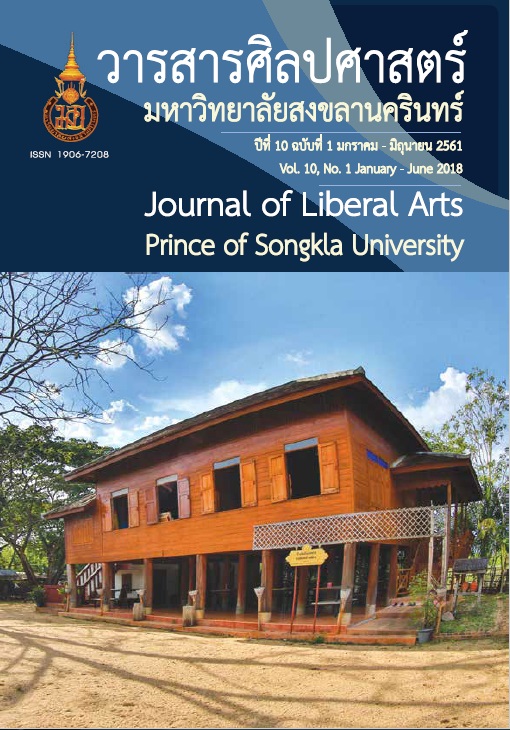การสร้างอุดมการณ์ทางการเมืองผ่านอุปลักษณ์ข้าวจากภาษิตเขมร
คำสำคัญ:
อุดมการณ์ทางการเมือง, ข้าว, อุปลักษณ์มโนทัศน์, ภาษิตเขมรบทคัดย่อ
บทความนี้มีวัตถุประสงค์เพื่อศึกษามโนทัศน์จากการใช้อุปลักษณ์ “ข้าว” ผ่านภาษิตเขมร และการใช้มโนทัศน์เหล่านั้นเพื่อวัตถุประสงค์ทางการเมืองผลการศึกษาพบว่า คนเขมรไม่ได้มองข้าวว่าเป็นเพียงแค่สิ่งที่ใช้บริโภคเท่านั้น แต่ยังเปรียบข้าวว่า เป็นมนุษย์ เป็นงาน เป็นเงิน เป็นความรู้ และเป็นมรดกอีกด้วยจากมโนทัศน์ดังกล่าวได้ถูกนำมาใช้เป็นเครื่องมือสำคัญเพื่อสร้างอุดมการณ์ทางการเมืองในยุคสร้างชาติ (ภายหลังจากที่เขมรได้รับเอกราชจากฝรั่งเศส) ดังปรากฏในตราประจำแผ่นดินและธนบัตร โดยสัญลักษณ์ข้าวสื่อความหมายว่าคือ 1) เกษตรกร ซึ่งเป็นประชากรส่วนใหญ่ของประเทศ (ข้าวเป็นมนุษย์) ข้าวหมายถึงอาชีพเกษตรกรรม (ข้าวเป็นงาน) ซึ่งเป็นศาสตร์ของแผ่นดิน (ข้าวเป็นความรู้) ที่ถ่ายทอดจากรุ่นสู่รุ่น (ข้าวเป็นมรดก) และแสดงให้เห็นถึงความอุดมสมบูรณ์ ความมั่นคงมั่งคั่ง (ข้าวเป็นเงิน) อีกด้วย
References
Heraldy of the world. (2017, March 13). National emblem of Cambodia. Retrieved From https://www.ngw.nl/heraldywiki/index.php?title=
National-Emblem-of-Cambodia.
Ministry of Education, Youth, and Sports. (2011). History Level 12. Phnom Penh: Publishing and Distribution House. [In Khmer]
Mogan. (2011, October 6). Perused some pics of coats of arms and flags of nations today. Retrieved from https://jimmorgan.word
press.com/2011/10/06/perused-some-pics-of-Coats-of-arms-and-flags-of-nations-today/.
Panpothong, N. (2013). A Linguistic approach to critical discourse analysis: Concepts and implementation of discourse studies in Thai language]. (2nded.). Bangkok: Academic dissemination project, Faculty of Arts, Chulalongkorn University. [In Thai]
Phanit, R. (2014). Conceptual metaphors of rice in Thai society. Mekong-Salween Civilization Studies Journal 5(2), 161-190. [In Thai]
Phin, S. (2011). Rice in Khmer tradition. Phnom Penh: Angkor Wat. [In Khmer]
Prach, W., et al. (2015). 100 things that you should know about Khmer. Phnom Penh: Dam Derm Civeut. [In Khmer]
Ratna, S. (2011). A history of the national flag and national anthem Nokoriat. n.p. [In Khmer]
Tedthong, U. (2005). Khmer proverbs: Ways of life and worldviews of Khmer people. (Doctoral dissertation).Graduate School, Silpakorn University.
[In Thai]
Thongdi, I. (1994). Rice culture: Rice rites and farming. Bangkok: Saha Dhamika. [In Thai]
Wikimedia commons. (2016, November 23). Emblem of democratic Kampuchea 1975-1979. Retrieved from https://commons. Wikimedia.
org/wiki/File: Emblem of Democratic Kampuchea 1975-1979.svg.
Yongbunkert, C. (2000). A Journal of Chenla’s Tradition. Bangkok: Matichon.
[In Thai]
Downloads
เผยแพร่แล้ว
How to Cite
ฉบับ
บท
License
ลิขสิทธิ์บทความเป็นของผู้เขียน แต่วารสารศิลปศาสตร์ มหาวิทยาลัยสงขลานครินทร์ ขอสงวนสิทธิ์ในการเป็นผู้ตีพิมพ์เผยแพร่เป็นครั้งแรก




